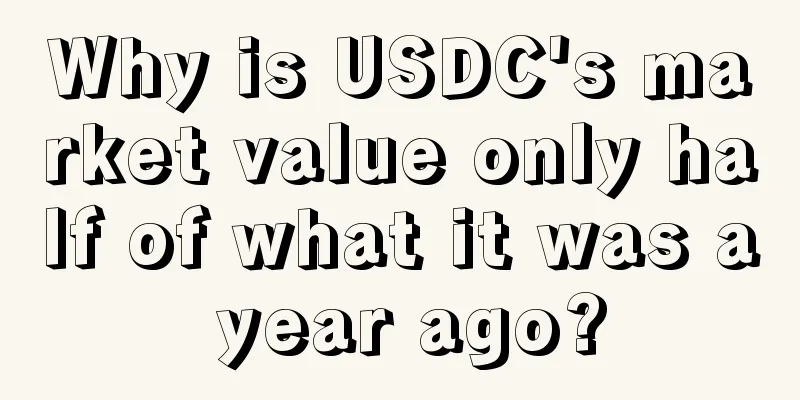Why is USDC's market value only half of what it was a year ago?

|
USDC’s market cap is roughly half of what it was a year ago and continues to decline. USDC is a stablecoin pegged to the U.S. dollar issued by crypto payment company Circle. The company said that since USDC reserves are managed by BlackRock, Bank of New York Mellon and other financial institutions, holders can redeem 1 USDC for 1 U.S. dollar. According to CoinGecko, USDC's market capitalization peaked at about $55 billion in late July 2022, before falling to about $44 billion by early March of this year. Since then, Circle's $3.3 billion in reserves at Silicon Valley Bank, which failed, has triggered a more severe decline. Circle later regained control of the funds after SVB received a federal bailout. However, according to industry observers, the problem caused the stablecoin to temporarily decouple from the peg, with the price falling to around $0.97, a situation that has led to lasting reputational damage for some. “The rapid price drop caused token holders to immediately lose trust in USDC’s stability, leading to billions of dollars in redemptions a few weeks later,” said Max Shannon, a researcher at CoinShares. “Token holders, in their fear and concern, may not have realized that Circle processed redemptions with ease, but they also suspended withdrawals over the weekend.” Regarding the suspension of withdrawals, it is not because of insufficient liquidity, but because Circle is connected to the traditional banking system. He added that although USDC can always be used on the chain, Circle's working hours are five days a week. According to data from CoinGecko, USDC's market value was about $26.7 billion on Tuesday, down about 2.5% since the beginning of July. A Circle spokesperson did not respond to a request for comment. Matteo Greco, research analyst at Fineqia International, noted that USDC’s main market is the United States, a country where cryptocurrency players are grappling with legal challenges in the absence of comprehensive regulation. “The SEC’s tough actions against the digital asset space are driving investors away from the U.S. market, so USDC is also taking a hit,” Greco told Blockworks. Tether Supply GrowthShannon said the continued decline in USDC’s circulating supply and market cap can be directly attributed to the rise of stablecoin competitor Tether (USDT). “Traders initially exited their positions knowing that Tether had no custodial risk within the U.S. banking system and therefore no peg was removed,” he told Blockworks in an email. “But the long-term trend is for deep liquidity to increase.” According to data from Coingecko, USDT's market capitalization was close to $84 billion on Tuesday, second only to Bitcoin (BTC) and Ethereum (ETH). This figure has increased by about 27% from $66 billion since July 2022. Tether is an exception, as the market capitalizations of other major stablecoins - including Binance Dollar (BUSD) and Dai (DAI) - have fallen by 50% or more from their respective record highs. Greco said that while some are skeptical about the specific level and extent of Tether’s backing, the growth of the stablecoin’s circulating supply is unquestionable. Tether is minted entirely on-chain, so the supply itself is tamper-proof. A company spokesperson told Blockworks in March that Tether holds a “strong, conservative and liquid portfolio” that includes short-term U.S. Treasuries and cash and cash equivalents. Use cases varyStablecoins are primarily used for trading and have the deepest liquidity pools across all major exchanges. They can also act as a safe haven in a risk-off environment when trading altcoins. Despite a 50% reduction in USDC supply over the past year, Greco said that USDC remains the preferred choice for many institutions. It has been strongly welcomed as a bridge between the real world and the digital asset space in a regulated environment. USDC is widely used in all protocols that tokenize real-world assets such as stocks, bonds, houses or luxury goods. While USDC is mainly used in the U.S. market, USDT dominates in Asia, a region that is gradually accepting stablecoins. Greco said Tether has been favored by crypto natives since 2014, who mainly use it for daily transactions and to provide liquidity in DeFi. It is also the preferred asset used by local crypto investors when they want to exit the market and adopt a neutral strategy without returning their funds to their bank accounts. |
>>: Hong Kong company issues stablecoin and lists it on Binance
Recommend
DNSExit free domain name corporate email DNS resolution and SSL certificate one-stop service
As a long-established domain name service provide...
Bitcoin price falls below $30,000 and makes Bloomberg front page
The news that Bitcoin price fell below $30,000 ma...
Mining machine hosting, cloud mining machine, cloud computing power are all confusing? Let me tell you all the tricks
A few days ago, Xiaolu chatted with everyone abou...
These ear signs indicate that your fortune is declining and you are destined to be poor.
Financial fortune has always been something we ar...
Palmistry: Fortune telling by the middle finger
Palmistry: Fortune telling by the middle finger T...
The computing power industry is a dream-making machine. Who will become a “giant”-level enterprise?
On April 25, the "2021 New Infrastructure Bl...
What does the influence line mean in palmistry?
Our palms are covered with fine lines, and each l...
How does a person with thick ears look like? His family is well off.
People with thick ears tend to have good luck. Th...
After reading this, I gasped. How was $100 million almost defrauded?
This article is based on the views of Arrow found...
Viewpoint | How do you view Filecoin’s resource collaboration and risk management?
. Professionalism and focus, win-win cooperation ...
What does a mole inside the eyebrow mean? Is it good luck for a woman to have a mole inside her eyebrow?
Moles, like other factors that affect one’s fate,...
Is it good for a woman to have a mole on her chin? She must be from a wealthy family with a lot of real estate and properties!
How to interpret a mole on a woman’s chin? In our...
Bitcoin payment app raises over $1 million in nine days
Plutus Tap & Pay, an upcoming Android mobile ...
What kind of men still have a "virgin complex"
What kind of men still have a "virgin comple...
A girl's intermittent lifeline means her husband is unreliable
How to read a girl’s lifeline? In traditional phy...









